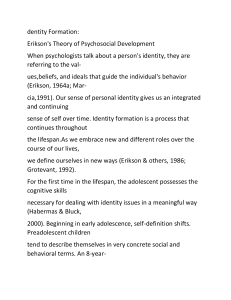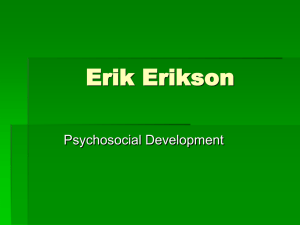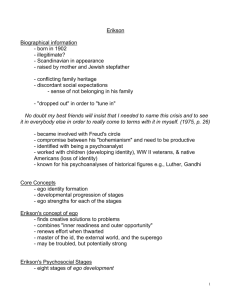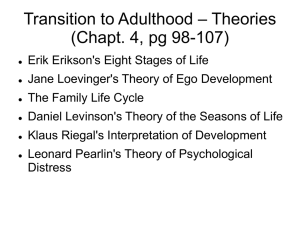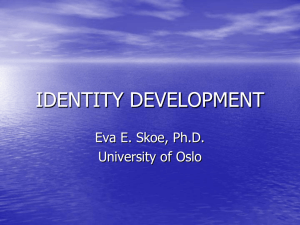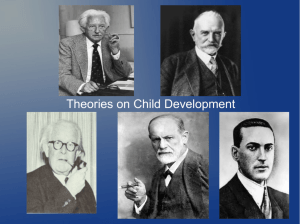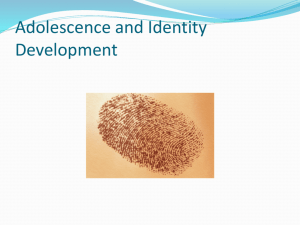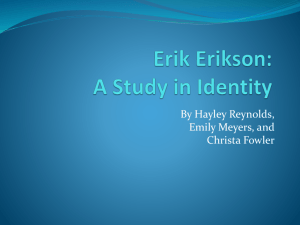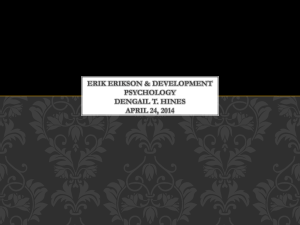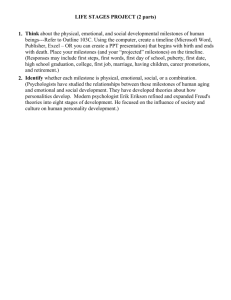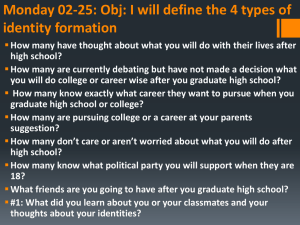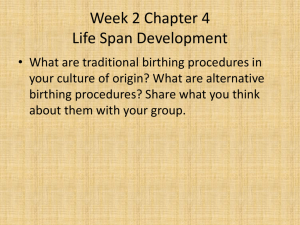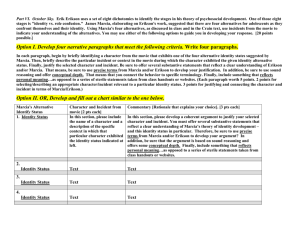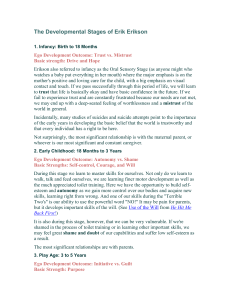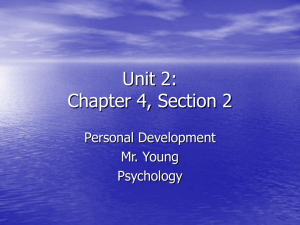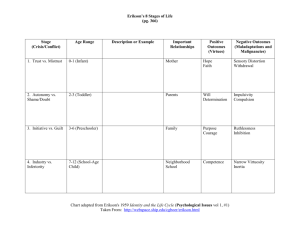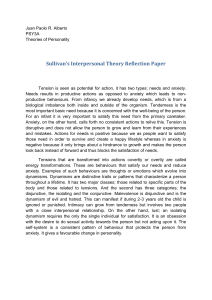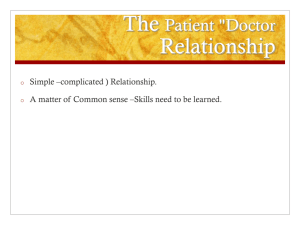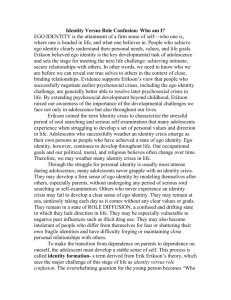Marcia JE. Development and validation of ego identity status. J
advertisement
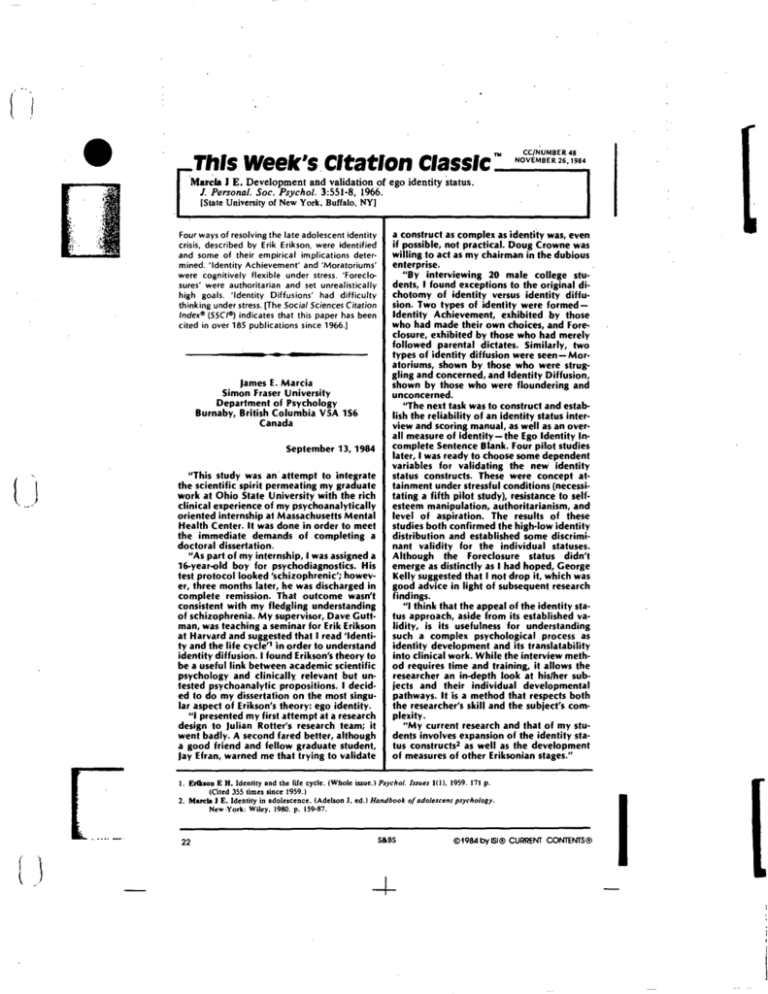
. [ CC/NUMBER 48 This Week’s Citation Classic’________ Marcia I E. Development and validation of ego identity status. I. Personal. Soc. Psycho!. 3:551-8, 1966. IState University of New York, Buffalo, NYJ Four ways of resolving the late adolescent identity crisis, described by Erik Erikson, were identified and some of their empirical implications determined. ‘Identity Achievement’ and ‘Moratoriums’ were cognitively flexible under stress. ‘Foreclosures’ were authoritarian and set unrealistically high goals. Identity Diffusions’ had difficulty thinking under 8 stress. (The Social Sciences Citation lndexx (SSCI ’) indicates that this paper has been cited in over 185 publications since 1966,1 — James E. Marcia Simon Fraser University Department of Psychology Burnaby, British Columbia V5A 1S6 Canada September 13, 1984 “This study was an attempt to integrate the scientific spirit permeating my graduate work at Ohio State University with the rich clinical experience of my psychoanalytically oriented internship at Massachusetts Mental Health Center. It was done in order to meet the immediate demands of completing a doctoral dissertation. “As part of my internship, I was assigned a 16-year-old boy for psychodiagnostics. His test protocol looked ‘schizophrenic’; however, three months later, he was discharged in complete remission. That outcome wasn’t consistent with my fledgling understanding of schizophrenia. My supervisor, Dave Guttman, was teaching a seminar for Erik Erikson at Harvard and suggested that I read ‘Identity and the life cycle” in order to understand identity diffusion. I found Erikson’s theory to be a useful link between academic scientific psychology and clinically relevant but untested psychoanalytic propositions. I decided to do my dissertation on the most singular aspect of Erikson’s theory: ego identity. “I presented my first attempt at a research design to Julian Rotter’s research team; it went badly. A second fared better, although a good friend and fellow graduate student, Jay Efran, warned me that trying to validate ,1 [T I I a construct as complex as identity was, even if possible, not practical. Doug Crowne was willing to act as my chairman in the dubious enterprise. ‘By interviewing 20 male college students, I found exceptions to the original dichotomy of identity versus identity diffusion. Two types of identity were formed— Identity Achievement, exhibited by those who had made their own choices, and Foreclosure, exhibited by those who had merely followed parental dictates. Similarly, two types of identity diffusion were seen—Moratoriums, shown by those who were struggling and concerned, and Identity Diffusion, shown by those who were floundering and unconcerned. “The next task was to construct and establish the reliability of an identity status interview and scoring manual, as well as an over~ all measure of identity—the Ego Identity Incomplete Sentence Blank. Four pilot studies later, I was ready to choose some dependent variables for validating the new identity status constructs. These were concept attainment under stressful conditions (necessitating a fifth pilot study), resistance to selfesteem manipulation, authoritarianism, and level of aspiration. The results of these studies both confirmed the high-low identity distribution and established some discriminant validity for the individual statuses. Although the Foreclosure status didn’t emerge as distinctly as I had hoped, George Kelly suggested that I not drop it, which was good advice in light of subsequent research findings. “1 think that the appeal of the identity status approach, aside from its established validity, is its usefulness for understanding such a complex psychological process as identity development and its translatability into clinical work. While the interview method requires time and training, it allows the researcher an in-depth look at hislher subjects and their individual developmental pathways. It is a method that respects both the researcher’s skill and the subject’s complexity. “My current research and that of my students involves2expansion of the identity status constructs as well as the development of measures of other Eriksonian stages.” I I. Erikeon E H. Identity and the life cycle. (Whole issue.) Psycho!. Issues 1(1). 1959. 171 p. (Cited 355 times since 1959.) 2. MarcIa I E. Identity in adoletcence. (Adelson J. ed.( Handbook of adolescent psychology. New’York: Wiley. 1980. p. 159’87. 22 S&BS @1984 by IS(® CURRENT CONTENTS® I
